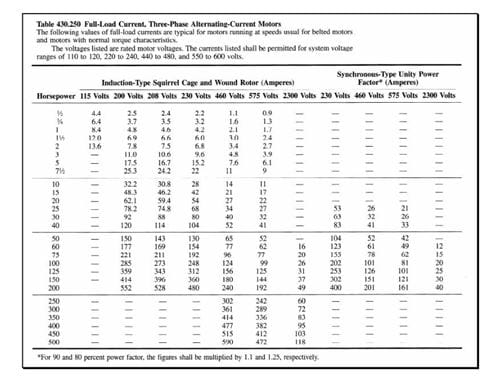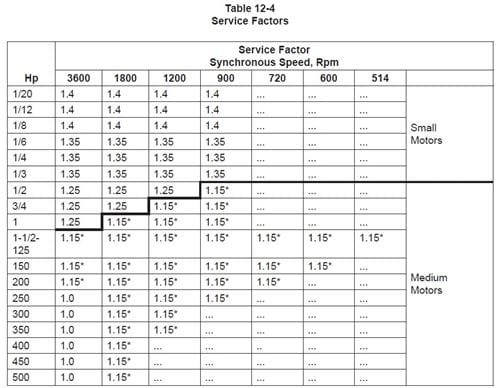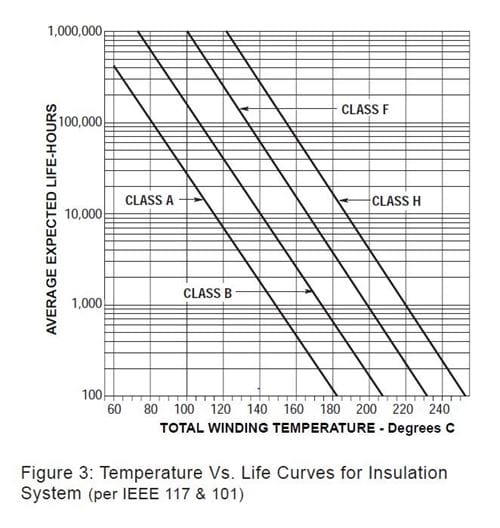
How service factor affects efficiency and motor life
July 2019
In our May 2019 blog article titled “Demystifying pool and spa electric motor nameplates,” we gave helpful information and tips for deciphering motor nameplates on pool and spa motors. One of those critical pieces of information included on nameplates is a motor’s service factor. According to NEMA Standard MG 1-2016: Motors & Generators, service factor refers to "a multiplier which, when applied to rated power, indicates a permissible power loading that may be carried under the conditions specified."
Service factor can be viewed as “extra margin” that allows motors to be run at higher loads when needed. Motors with a 1.0 service factor can be run at 100% of their rated loads and aren’t designed to be safely run above that level. A motor with a service factor of 1.25 is designed to put out 25% more power than its rated load when run in its service factor area.
There are tradeoffs to operating motors at levels above their rated loads, especially when doing so for long periods of time. Continuously operating motors in their service factor area may lead to decreased efficiency, overheating and degradation of wire insulation. This can also lead to a much shorter motor life.
According to Tim Albers, Nidec Motor Corporation’s (NMC) Director of Product Management, NMC’s standard sinewave motors typically have defined service factors of 1.15 or 1.25. Many of these motors have a Class B or lower temperature rise at 1.0 service factor and are designed to be less than Class F temperature rise at whatever their service factor is. That’s a temperature rise of roughly 80 degrees maximum for Class B and roughly 125 degrees maximum for Class F at service factor.
Motors are often paired with inverters because they can withstand the increased voltage spikes that variable frequency drives (VFDs) put out. They may be also able to run at extremely low speeds without the danger of overheating. Albers pointed out that pairing a motor with an inverter basically means negating any potential load margin. When NMC builds dedicated inverter duty motors, they are nameplated as having a 1.0 service factor. The primary reason is that drives are sized based on amps according to requirements set by the National Electric Code (NEC), a voluntary organization that writes the electrical codes that are then adopted by states and cities across the United States.

Figure 1 from NEC.
The National Electrical Manufacturers Association (NEMA) sets certain standards for electrical enclosures and motors in North America. NEMA standards allow for service factors above 1.0, and the organization publishes a table setting out specific standards for various amp ratings. The International Electrotechnical Commission (IEC), on the other hand, sets a global standard of a 1.0 service factor.
According to Albers, “As a standard, the IEC calls for a 1.0 service factor and does not apply an incremental service factor. Their requirement stipulates that the motor should be designed for the rated horsepower level that it should actually be.” Another difference between NEMA and IEC standards is that NEMA allows for a larger voltage range. With NEMA, there is a ± 10% allowance, whereas IEC standards only allow for a ± 5% voltage range.
Figure 2 from NEMA.
Albers stated that the NEMA standards for smaller-horsepower motors like pool and spa motors allow for service factors that run up to 1.35 or even higher—some even as high as 1.5. This is because they run much cooler thermally speaking. Temperature is an important factor when it comes to insulation life and overall lifetime of the motor. That can be one of the major pitfalls with continuously operating motors in the service factor area. The higher the load you run a motor at, the higher the temperature will rise. In fact, for every 10 degrees hotter a motor runs, insulation life can be expected to reduce by approximately half.
Figure 3 from Nidec Motor Corporation.
According to Albers, efficiency levels also start to drop as temperature rises. “And now you might look at the numbers and say, ‘I only got 15% more horsepower, but you’re telling me that the temperature rise went up by 50%?’ And the answer to that is yes.” He stated that this is because the optimal design point is at or below the full load level. When you increase it above that, the temperature starts to rise more steeply. “So now your efficiency starts to actually go down, which means it gets even hotter, and the load increases. All of this will in turn reduce the life of the motor.”
Albers said that continuously running a motor in the service factor area can negatively impact a motor’s life. “While motors are designed to safely run at service factor when necessary, the insulation will wear out at a much faster rate. Let’s say you have a motor with an average life of about 17 years. Running that motor constantly in the service factor area means there’s a good chance that the motor will last only 8 or 9 years.” He stressed that this goes for more than just the motor’s insulation. “It’s the same thing for the grease in the bearings; even the bearings themselves won’t last as long.”
Albers related an example he felt showed a great use for running motors at service factor. “We have a customer who operates their pumping motor at just above its full load point. Just 2-4% above that. What happens is that over the course of years in operation, the nozzle starts to corrode and gets more clogged. Eventually, that motor gets into the service factor area and they order new nozzles. After they perform maintenance to replace the nozzles, the motor goes back to the design point and they start all over again. To me, that’s an example of service factor that makes a lot of sense. It’s a use that will help get the longest life out of a motor.”
Timothy Albers is the Director of Product Management for Nidec Motor Corporation’s Commercial and Industrial Motor Division/US Motors. His current responsibilities include product management, product planning and new product development for the Commercial and Industrial motors. Mr. Albers has held various positions in marketing for Nidec Motor Corporation and Emerson Motor Company over the last twenty-two years, including Product-line Manager for NEMA motors. He is a Senior Member of IEEE and serves on many Hydraulic Institute technical committees. His past experience includes various Marketing and product development positions at U.S. Motors/Emerson and other marketing and sales positions in electric motors and drives at General Electric Company. He also spent 12 years active and reserves as a U. S. Navy officer and was a qualified operating engineering officer.
Sources:
https://www.plantengineering.com/articles/defining-motor-service-factor/
http://www.icsenggroup.com/motor-service-factor.shtml



